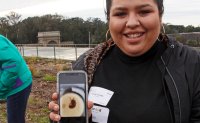Using Smartphones to Support Learning in Nature
Technology, used appropriately, can be a tool for thoughtful observation, enhancing students’ interactions with the natural world.
Your content has been saved!
Go to My Saved Content.“Kids need to stop staring at screens and go outside.” It’s a familiar refrain sung by educators, parents, and adults of all stripes. We fear that young people, hypnotized by smartphones and other devices, are losing meaningful connection with the natural world. That fear is not unreasonable, but most educators also understand that if students are not engaged and competent technologically, they will be left behind.
We have convincing research that suggests young brains are being restructured by pervasive technology. It’s also not hard to find high quality research demonstrating the benefits of physical activity and exposure to nature, not just in terms of young people’s general well-being but in the area that most matters to educators: student performance. Given all this, it’s easy to buy into the simple dichotomy: screens bad, trees good.
I’m an outdoor educator who works with students from prekindergarten through 12th grade at a public charter school in Washington, DC. At every developmental stage, I hear from teachers, administrators, and parents that students need time away from the classroom, out of their seats, off their screens, and in nature. Whether the rationale is academic fieldwork or just a day hike along the river, adults recognize the importance of young people being in nature. And the first rule typically imposed on such excursions? No phones! Phones, it is assumed, will suck students back into the virtual world and diminish the purity of their experience.
Using Phones for Outdoor Learning
Perhaps we should reconsider this nature/technology split, though. Zia Hassan, an education technology consultant and author of Creating the Modern Classroom—and a former colleague of mine—told me, “We often think that the natural world is separate from the world of tech, that being in nature is synonymous with unplugging. Nature can be a way to unplug and relax, but the appropriate technology can enhance the experience of interacting with nature, instead of detract.” That’s true—smartphones are infuriatingly ubiquitous, but they can also be tools for thoughtful observation and serious research.
Young people in particular interact with the world quite effectively via their phones. I’ve seen this firsthand: Things quickly looked over—or overlooked—take on new significance when viewed through the smartphone screen, so facilitating effective observation with technological tools can enhance outdoor experiences.
My outdated iPhone 7, for example, is a source of amusement for and ridicule from my students. But the magnification feature—enabled through the accessibility features—captivates them. They love the close-up, detailed images. They’re entranced by the inside of a flower, amazed by the pollen on a bumblebee’s labial appendages. Otherwise uncooperative living specimens can be examined and analyzed in all of their precise detail.

There’s an App for That
Detailed images also become the basis for deeper exploration and documentation back in the classroom, tying a memorable, sometimes even profound, experience in the outdoors directly to the academic work at hand. Here again phone-based technology comes in handy through the many apps and websites available to aid identification and research.
One such app is iNaturalist, developed by the California Academy of Science and National Geographic. The app’s more than 1 million registered users range from top scientists to naturalist-hobbyists to students, who together map biodiversity across the globe. Students are networked with a wide range of experts, adding their original research to a growing database used by professional and amateur scientists alike.
I particularly like the identification features in iNaturalist. Students can submit images and have those images identified and catalogued, often within a few hours. From there, research—on iNaturalist and across the web—provides added context and information about the images.
Project Noah is also great for tying a classroom to the natural world. The app allows students to participate in “missions” such as worldwide surveying and cataloguing of birds, moths, spiders, and other animals, plants, and even fungi. There is also a place specifically for educators to set up and keep track of their students’ work.
There are plenty of other apps one might also consider for more specific needs. I encourage educators to search out tools that best suit their needs, keeping in mind that smartphones are incredibly powerful learning and observation aids—even when we’re trying to get students to engage with the natural world.
But apps and technology don’t let us off the hook as educators, especially in nature. In fact, deciding to take tech out into nature in some ways increases our responsibility to have meaningful and authentic experiences. What matters isn’t how many insects or mushrooms a student can tick off on an app. What matters is the ability to engage individuals—students and educators—in the beauty and wonder of the world. We can’t underestimate the power of beauty and wonder.
Technology, applied irresponsibly, can interfere with observation and kill curiosity. It can also, when used wisely, open new worlds, giving us tools to observe in finer detail, to research our questions and share our joy of nature as we come to appreciate the pretechnological world around us.
